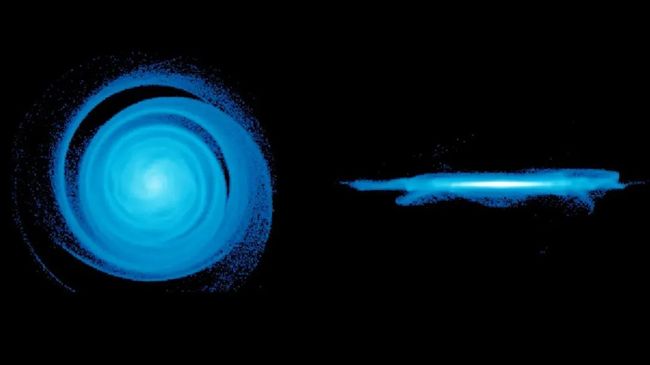Ripples Detected in Ancient Spiral Galaxy Offer Clues to Milky Way’s Origins
ALMA’s Study of Distant Spiral Galaxy BRI 1335-0417 Uncovers Far-reaching Seismic Ripples
Observations have unveiled seismic waves in an ancient galaxy for the first time, potentially providing fresh insights into the genesis of our Milky Way. The galaxy, identified as BRI 1335-0417, surpasses 12 billion years in age, marking it as the oldest and most distant spiral galaxy in our known universe. Through the Atacama Large Millimeter/submillimeter Array (ALMA) radio telescope in Chile, scientists scrutinized gas movements encircling the galaxy, capturing the emergence of a seismic wave—never previously witnessed in an early galaxy, as stated by the Australian National University.

Lead researcher Takafumi Tsukui highlighted, “Our focus lay in understanding the gas flow within the galaxy, crucial in star formation and illuminating a galaxy’s fueling process.”
ALMA’s findings depicted the galaxy’s disk—a blend of rotating stars, gas, and dust—with ripples akin to those radiating across a pond post a thrown stone. The team theorizes these ripples stem from external factors, like fresh gas influxes or interactions with smaller neighboring galaxies, both potentially augmenting star formation by supplying additional fuel.
“Both scenarios could significantly enhance star formation by supplying fresh fuel,” Tsukui emphasized.
Additionally, researchers observed a bar-shaped structure in the galaxy’s disk—a remote formation of its kind—disrupting gas motion within spiral galaxies and channeling it toward the galactic center.
BRI 1335-0417 stands as an ancient galaxy from an era when the universe was merely 10 percent of its current age. While spiral configurations are scarce in the early universe, BRI 1335-0417 was specifically targeted to unravel the formation of such galaxies and their fuel supply mechanisms for rapid star birth.
“Early galaxies exhibited substantially swifter star formation rates compared to modern ones,” remarked study co-author Emily Wisnioski. “BRI 1335-0417, despite similar mass to our Milky Way, fosters star creation several hundred times faster.”
ALMA’s observations, complemented by computer simulations, contribute to unraveling the evolutionary narrative of BRI 1335-0417, detailing its gas accumulation and subsequent star generation.
Their findings were published Nov. 23, 2023 in the Monthly Notices of the Royal Astronomical Society.
Do not forget to share your opinion with us to provide you with the best posts !



0 Comments